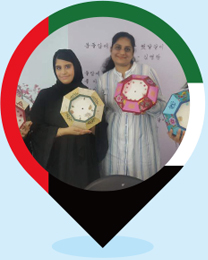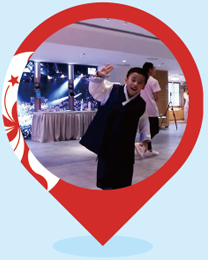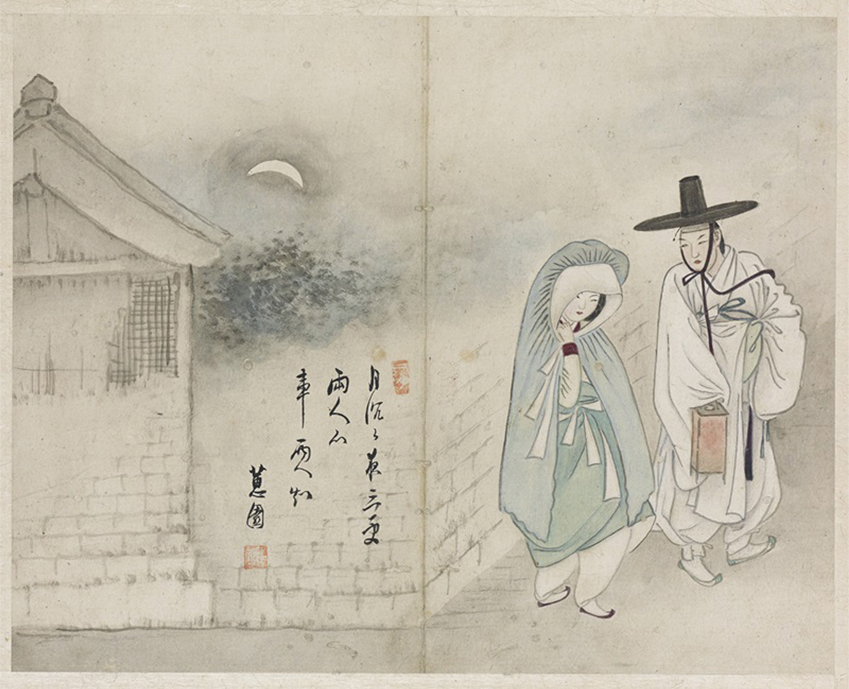Global Korea I
Korean Lectures
Held to Mark
Ramadan
UAE

The Korean Cultural Center (KCC) in Abu Dhabi, the capital of the United Arab Emirates (UAE), held lectures on Korean culture to mark Ramadan. Classes on Hanji (traditional Korean paper) crafts, Korean paintings and women’s crafts were modified to reflect a Ramadan theme.
Similar to the Korean custom observed on New Year’s Day, children in the UAE receive blessings from adults and small gifts or pocket money after Ramadan. Given this tradition, the classes focused on making an octagonal clock from Hanji and bokjumeoni (a fortune pouch) to hold cash.
A Korean painting class introduced how to draw traditional lanterns with a star and crescent, two things considered symbols of Islam. Just as the lanterns are put up during celebratory events or festivals, decorations featuring the crescent moon and light mark Ramadan throughout the city.
An Emirati woman who participated in the women’s crafts class said, “Ramadan culture in the UAE and Korean holiday traditions have a lot in common. Particularly, I found it interesting that Koreans also give money to children on Seollal (Lunar New Year’s Day) just like we do during Eid al-Fitr (Festival of Breaking the Fast), which marks the end of Ramadan. I’d like to keep attending special lectures held by the KCC.”
The KCC in Abu Dhabi runs a variety of cultural lectures on the Korean language, taekwondo, Korean cuisine, drawing, Hanji and women’s crafts year round.
Summer
Cloth to Beat
the Heat
Hong Kong

The KCC in Hong Kong hosted an event for trying on traditional Korean attire during Korean Traditional Culture Week. In collaboration with Seocheon-gun County in Korea’s Chungcheongnam-do Province, the traditional summer cloth Hansan mosi (fine ramie) was introduced to Hong Kong residents. The weaving of mosi is on UNESCO’s list of Intangible Cultural Heritage of Humanity.
Though the intense heat and protests in Hong Kong hindered foot traffic around the KCC, nearly 130 visitors still showed up over two days. Not only city residents but people from other countries like Taiwan and the Philippines also went to try on Hanbok (traditional Korean costume). The programs were especially well received by families with children.
For those unfamiliar with Hansan mosi, videos of mosi weaving were shown at the KCC’s multimedia room. Visitors also got to experience mosi and received small mosi items at the end of the event.
One Hong Kong resident said, “The ramie plant also grows in Hong Kong but I think the weaving technique hasn’t been preserved here. It’s impressive that traditional mosi weaving has been well preserved and passed down in Korea. I’m planning to visit the Hansan Mosi Cultural Festival next year to learn more about mosi.”
Another visitor added, “I’ve only seen Hanbok on TV shows or historical dramas. It was such a fun and memorable experience to try it on here in Hong Kong.”
The KCC in Hong Kong will host more Hanbok experiential programs in the second half of the year.
Global Korea II · Written by Korea.net Honorary Reporter Sarah Oqelee from Egypt Photo courtesy of Korea.net
An Arab Critique of a Joseon
Dynasty Genre Painting
“Thin rain falls deep into midnight outside the window.
Only two people will know their own feelings.
Their joy is not insufficient yet the sky is brightening,
And so they grab their silk clothes and set up their next meeting.”

“Weolha Jeongin” (월하정인, 月下情人) is a genre painting by Shin Yoon-bok, an artist of the late Joseon Dynasty (1392-1910). The work’s title in English means “Two Lovers Under the Moonlight.”
This poem by Kim Myeong-won (1534-1602), a civil servant of the Joseon Dynasty (1392-1910), reminds me of the painting “Weolha Jeong-in” (월하정인, 月下情人) by Shin Yoon-bok, an artist of the late Joseon era. The title of this satirical genre painting means “Two Lovers Under the Moonlight.”
When I first saw this painting in an Arabic-language magazine published in Korea, I took to it right away, especially because of its vivid colors and a theme that defied Joseon’s conservative norms. A closer look at the woman and the man in the painting shows that she resembles a gisaeng (a female entertainer) and he seems like an aristocrat. Due to the rigid hierarchy of the Joseon class system, their rendezvous can be inferred as being socially forbidden. Perhaps this is why they can meet only late at night.
I wondered how the painter conveyed the emotions of both lovers in the painting, so I looked closer at their expressions. The woman looks angry and the man nervous; she seems upset because he was late since she waited quite a while for him. But she also looks like she is trying to talk to him and likes him. He is reaching for something in his clothes, like trying to hand her something. Perhaps a gift or a letter?
The painting portrays the restrictions imposed on the love lives of Joseon-era subjects, something that I feel remains in contemporary society. Despite the liberal changes human society has undergone, men and women still face barriers in love due to differences in religion, social perceptions and other reasons. Yet interactions between lovers are easier today thanks to social media.



































